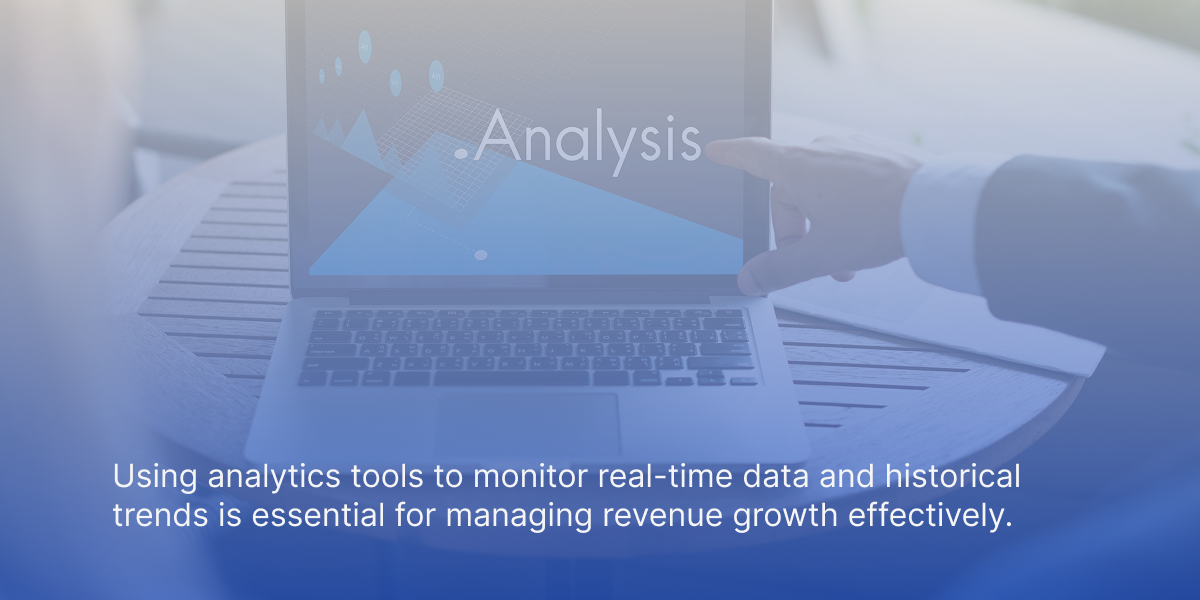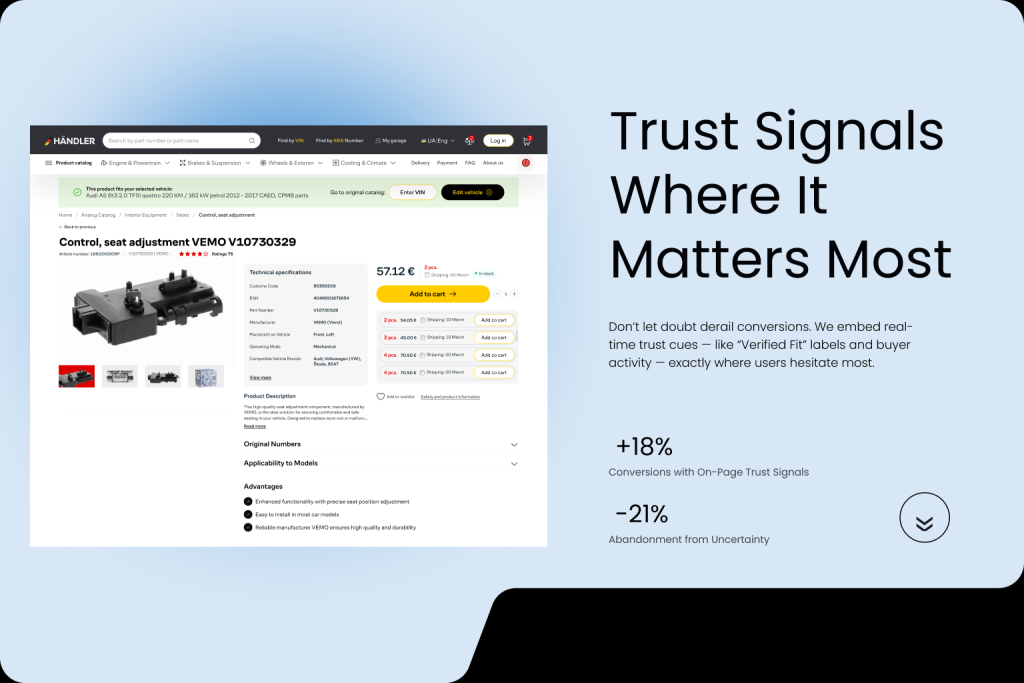The revenue growth rate formula shows how quickly your company’s revenue is increasing. This simple calculation is crucial for understanding business health and making informed decisions. In this article, you will learn how to use the revenue growth rate formula to measure and improve your company’s performance.
Key Takeaways
- Revenue growth is calculated by comparing the current period’s revenue to that of the previous period, providing critical insights into a company’s financial health and understanding the company’s revenue over different periods.
- High revenue growth rates attract investors and are vital for strategic planning, but businesses must also monitor key metrics like Customer Acquisition Cost (CAC) and Churn Rate for sustainable growth.
- Utilizing analytics tools for real-time data reporting and historical data analysis enhances decision-making and allows businesses to adapt strategies promptly to maximize revenue growth.
Understanding Revenue Growth
Revenue growth signifies the escalation in a company’s earnings from one period to the next, which serves as an indicator of how quickly revenue is expanding. Revenue growth refers to an increase in revenue over a specific period and is calculated by deducting the revenue from an earlier period from that of a more recent period and then dividing this difference by the earlier period’s revenue. This measure is commonly converted into a percentage for ease of interpretation and comparison over specific time spans.
An upward trend in revenue growth rate means that there’s an uptick in generated revenues compared to past periods, signaling robust business health and potential expansion. The term “revenue growth” encompasses what may be deemed satisfactory performance improvement rates when appraised across varied timescales such as yearly, quarterly, or monthly intervals—this enables businesses to monitor their progression consistently.
By examining changes in revenue over assorted durations, stakeholders can gain insights into how income streams are evolving while gauging the effectiveness of strategic choices made against prevailing market dynamics.
Importance of Revenue Growth
Revenue growth is a critical measure of business health and prosperity. It’s frequently targeted by investors as it signals the company’s future prospects. Revenue performance plays an essential role in determining the worth of a company, making it crucial for garnering investor interest and fostering opportunities for mergers or acquisitions.
Revenue growth offers valuable intelligence that aids in shaping long-term strategic initiatives. Recognizing patterns can guide more informed choices and potentially steer companies towards success through adept management of revenue expansion. However, it is essential to balance revenue growth with cash flow to ensure long-term stability and avoid the pitfalls of prioritizing short-term gains at the expense of financial health.
Access to up-to-the-minute financial information improves decision-making by allowing rapid identification of emerging trends and better risk control. The immediate availability of data regarding revenue supports faster decisions, contributing to enhanced precision in financial matters.
The Revenue Growth Formula
To determine the rate of revenue growth, apply the formula for calculating this metric: subtract the previous period’s revenue from that of the current period and then divide by the previous period’s revenue. This calculation offers a direct comparison between income generated in two consecutive periods to identify any upward or downward trends. For example, if an organization’s recent earnings are less than its prior earnings, it indicates a negative growth rate.
This indicator measures how much a business has expanded by representing increases in performance as well as financial gains over time, which is vital for keeping track of advancements in company revenue. Regular use of this method allows companies to keep an eye on their progress and supports informed strategic decisions based on hard data.
Employing this analysis is crucial not just for evaluating past success, but also serves as a foundation when designing marketing initiatives, establishing sales goals, and charting out strategies aimed at future expansion.
Steps to Calculate Revenue Growth Rate
Calculating revenue growth is possible for various periods, including yearly, quarterly, or monthly intervals. It’s crucial to compare timeframes of equal duration to maintain consistency. Continuously determining the rate of revenue growth assists in monitoring organizational expansion and evaluating the effectiveness of business processes.
Employing this basic computation aids companies in creating marketing plans, establishing sales goals, and planning for recruitment needs. For precise evaluation of growth rates, it’s important that the same timeframe lengths are compared against one another.
Subsequent sections will delve into how to compute growth figures for monthly revenue increases as well as those on a quarterly and annual basis.
Monthly Revenue Growth Calculation
The calculation of monthly revenue growth involves gauging the rise in earnings from one revenue month to another. To determine this, use the equation: (Revenue of Current Month – Revenue of Previous Month) / Revenue of Previous Month. Utilizing this formula enables businesses to monitor their short-term achievements and modify approaches promptly when necessary.
To figure out the rate at which revenue is growing each month, you subtract the previous month’s revenue from that of the current month, divide by last month’s figures, and multiply by 100 to express it as a percentage. Engaging in these calculations aids companies in keeping track of how well they are doing on a regular basis and helps them calculate growth rates so they can make strategic choices aimed at enhancing their operations.
Quarterly Revenue Growth Calculation
To assess the growth of period revenue on a quarterly basis, one should determine the variance in revenues between subsequent quarters by subtracting the previous quarter’s revenue from that of the current quarter. This figure is then divided by the initial quarter’s revenue and multiplied by 100 to express it as a percentage. Analyzing this metric is vital for gauging a company’s short-term financial progress and identifying patterns in its earnings.
Taking an instance where Q1 has generated $100,000 while Q2 produced $120,000 in revenue, you would calculate growth like this: ((120,000 – 100,000) / 100,000) which results in a growth rate of 20%. These calculations provide critical information about how well the business is doing and help shape strategies moving into future periods.
Annual Revenue Growth Calculation
Annual revenue growth signifies the rise in a company’s income from one year to the next, which is pivotal for gauging business progress. The yoy growth rate, or year-over-year growth rate, is a key metric in this context, highlighting how revenue growth can vary by industry and company maturity. Recognizing the annual growth rate is vital for assessing corporate achievements and appealing to prospective investors.
To calculate annual revenue growth, ascertain the total income of both the current and preceding years, then use this formula: (Current Year Revenue – Previous Year Revenue) / Previous Year Revenue. This measure assists in pinpointing sustained trends and supports planning strategies aimed at future expansion.
Factors Influencing Revenue Growth
Revenue growth can provide insights into the effectiveness of various business strategies and initiatives. Internal factors, such as pricing and scalability, play a significant role in shaping revenue growth. Increasing production, creating new products, and entering new markets are internal strategies that can drive revenue growth strategy.
As a company matures, its revenue growth rate may stabilize compared to the rapid growth seen in its early stages, influencing how success is measured and perceived.
External factors also significantly impact revenue growth and can influence revenue growth. Here are some key factors affecting revenue growth that affect revenue growth:
- Technological advancements enhance operational efficiency and improve customer service, contributing to revenue growth.
- Regulatory changes can open new markets or impose additional costs, affecting revenue growth trajectory.
- Economic changes influence consumer spending habits, directly impacting revenue growth.
The competitive landscape may compel companies to innovate and adjust pricing strategies to maintain market share. Enhanced customer experience through responsive design and effective selling techniques drives revenue growth. Comparing revenue changes with other records helps decipher the factors contributing to revenue growth. Identifying external factors helps understand their impact on sales and revenue growth.
Key Metrics Affecting Revenue Growth
Crucial metrics define and quantify expansion. Concentrating exclusively on the revenue growth rate might provide an incomplete picture because it doesn’t take into account earnings and operating costs. Most firms experience a yearly growth of approximately 70%.
Understanding the company’s revenue growth rate is essential as it highlights the business’s financial health and potential for future expansion. In terms of public SaaS businesses in the United States that report revenues around $100 million, the median revenue growth rate stands at 22%. An acceptable growth rate is influenced by factors like a company’s scale and lifespan. This number can fluctuate from 15% to more than 45%.
As companies progress towards maturity, they often see their initially high revenue growth rates level off. This illustrates how complexly intertwined various aspects are within the dynamics of SaaS revenues.
Customer Acquisition Cost (CAC)
Customer Acquisition Cost (CAC) reflects the average expense needed to gain a new paying customer, indicating marketing efficiency. It is calculated by dividing total acquisition costs by the number of customers acquired. CAC relates to Customer Lifetime Value (CLV), which estimates total revenue from a single customer over their relationship.
A high CAC compared to CLV indicates unsustainable customer acquisition strategies, necessitating optimization of marketing and sales efforts for balanced and profitable acquisition.
Churn Rate
The churn rate is a key indicator of the proportion of customers discontinuing their use of a product or service and is essential for evaluating revenue growth. When customer churn rates are elevated, they can severely impede revenue expansion by diminishing the contributions from newly acquired customers.
Retaining the existing customer base is crucial for long-term revenue sustainability, as it helps in reducing churn and optimizing the relationship with current customers.
To determine the customer churn rate, one uses this formula: take the number of lost customers and divide it by the total number of active customers at the start of that period. Then multiply by 100. This metric directly influences how stable revenue growth will be in businesses with subscription models.
By implementing predictive strategies aimed at identifying which customers are likely to leave, companies can effectively control and manage customer churn.
Average Revenue Per User (ARPU)
Average Revenue Per User (ARPU) informs companies about their revenue potential and aids in refining pricing strategies. Calculating ARPU helps businesses gauge average revenue per user, identifying growth opportunities and areas for improvement.
ARPU insights enable informed decisions about marketing, sales, and customer retention strategies. It helps set realistic revenue targets and align business strategies with customer value, boosting revenue growth.
Strategies to Boost Revenue Growth
Re-engaging former customers often requires less effort than attracting new ones. Customer retention stabilizes revenue and promotes upselling opportunities. A strong reputation for quality attracts new customers and retains existing ones. Communicating with repeat customers enhances customer success and sales.
Understanding revenue changes and exploring the underlying causes are crucial for developing successful revenue growth strategies, particularly in adapting to modern technological advancements.
Customer feedback gathered through surveys refines marketing strategies. Reassessing pricing strategies can increase revenue without changing sales strategies volume. Removing shipping fees encourages customers to complete purchases.
Geographic expansion can occur through physical locations or extended delivery services. Participation in professional community organizations enhances visibility and sales. Regular updates to sales channels maintain customer interest and boost engagement. Bundling products incentivizes customers to purchase more items. Introducing complementary products boosts sales and meets customer needs.
Tracking and Managing Revenue Growth
Maintaining a vigilant eye on revenue growth through consistent tracking over diverse time frames is essential for understanding how a business is progressing. By tracking revenue growth, companies can discern patterns, make enlightened choices, and tweak their approaches when necessary. Leveraging an assortment of instruments and techniques improves the precision and efficacy with which revenue expansion is tracked and governed.
In order to monitor revenue increments adeptly, analytics tools are indispensable. They empower enterprises to observe metrics as they unfold in real-time, scrutinize historical figures, and form decisions rooted in data. Calculating revenue increases routinely enables organizations to map out their advancement trajectory meticulously, ensuring that they remain aligned with their ambitions.
Using Analytics Tools
Monitoring revenue growth is effectively accomplished with the aid of analytics tools. These instruments allow companies to follow important metrics, scrutinize data, and make decisions based on solid information. Utilizing these tools is crucial for planning future growth, as they enable businesses to pivot resources towards core revenue drivers while providing insights that can lead to informed decision-making and sustainable revenue growth.
Assessing Customer Acquisition Cost (CAC) gives businesses insight into how efficient their marketing strategies are at drawing in new customers, which aids in maintaining balanced and sustainable expansion.
Real-Time Data Reporting
Identifying trends and forming strategic decisions to improve revenue growth is crucial, and real-time data plays a key role in this process. Businesses leverage analytics tools that monitor real-time metrics, providing instant feedback on how revenue is performing.
Real-time data is essential for identifying growth opportunities, potentially leading to better investment opportunities and scalable partnerships.
By analyzing historical data, companies can place current trends observed in real-time into context. This enhances the accuracy of future revenue forecasting by understanding past patterns.
Historical Data Analysis
Analyzing historical data across different time periods assists in predicting future trends related to revenue by uncovering patterns of past performance. Analyzing previous revenue data enables companies to base strategic decisions on established historical outcomes.
By examining the trends of past revenue growth, businesses can pinpoint recurring patterns that are instrumental in shaping strategies for the future. Historical evaluations may expose cyclical tendencies that forecast variations in seasonal revenue.
Summary
Grasping the fundamental aspects of revenue growth is critical, as it includes not only comprehending its main concepts but also being adept at calculating it precisely and recognizing the contributing factors and indicators that shape it. The significance of revenue growth cannot be overstated—it’s a key indicator for evaluating company performance, drawing investor interest, and steering tactical business decisions. Revenue growth is a crucial metric reflecting a company’s performance and its potential for growth. Employing the formula for revenue growth enables organizations to consistently monitor their progression and make choices that could positively impact their performance.
Companies seeking to amplify their revenue growth can implement various tactics like enhancing customer retention efforts, revisiting pricing strategies, or utilizing insights gathered from client feedback. It is vital for businesses to keep track of and manage their revenue expansion through the use of analytical tools that offer access to real-time data reporting along with an examination of historical trends. By harnessing these approaches and the knowledge gained thereof, enterprises are better equipped to navigate towards enduring prosperity and achievement.
Frequently Asked Questions

How do you calculate revenue growth rate?
To determine the rate of growth in revenue, apply the following formula: subtract the previous period’s revenue from the current period’s revenue and then divide this difference by the previous period’s revenue.
By doing so, one can evaluate whether revenues have increased or decreased when comparing two distinct periods.
Why is revenue growth important for a business?
Revenue growth is essential as it directly reflects a business’s performance and financial health, guiding strategic decisions and attracting investors.
This growth enables a company to achieve long-term success and sustainability.
What are the key metrics affecting revenue growth?
Critical insights into customer behavior, acquisition efficiency, and overall revenue potential are driven by key metrics such as Customer Acquisition Cost (CAC), churn rate, and Average Revenue Per User (ARPU). These factors significantly impact the growth of revenue.
By rigorously tracking these metrics, strategic decisions can be informed to bolster growth.
How can businesses boost their revenue growth?
To boost revenue growth, businesses should focus on improving customer retention, reassessing pricing strategies, expanding into new markets, and leveraging customer feedback.
These strategies are essential for achieving increased and sustained revenue growth.
What is the role of analytics tools in revenue growth management?
Analytics tools play a crucial role in revenue growth management by enabling businesses to track key metrics and analyze data effectively. This allows for informed decision-making that promotes sustained growth and financial stability.











